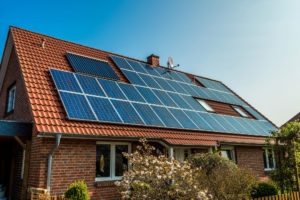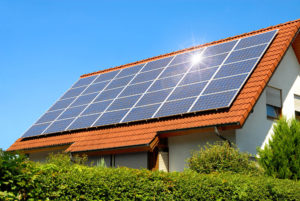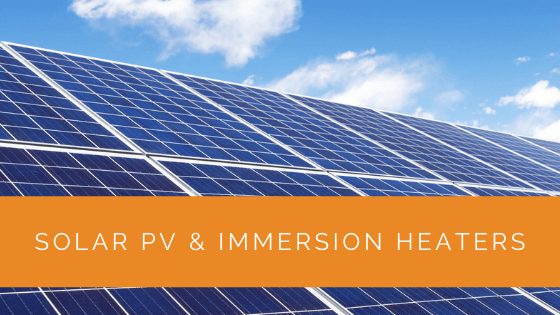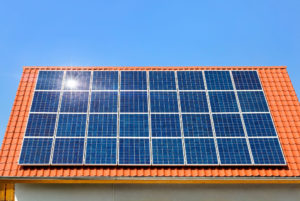As our world becomes more environmentally conscious, sustainable energy solutions have become increasingly popular among homeowners. Solar PV systems are one such solution, offering an eco-friendly way to generate electricity from the sun. But did you know that you can take this a step further and also utilize your Solar PV to produce free hot water?
In this comprehensive guide, we’ll explore the world of Solar PV and Immersion Heaters, teaching you how these two technologies can work together to maximize your energy savings and reduce your carbon footprint. We’ll delve into the mechanics of how this system functions, the benefits it offers, and why it’s a smart investment for homeowners who are committed to living sustainably. Whether you’re new to solar technology or looking to enhance your existing setup, our guide will equip you with the knowledge needed to make the most of Solar PV and Immersion Heaters. Say goodbye to excessive electricity bills and hello to a greener, more cost-effective way of living with this game-changing technology.
Contents
- 1 Key Takeaways
- 2 What Is a Solar PV and Immersion Heater?
- 3 How Do Solar PV Power Immersion Heaters?
- 4 How Does the Solar PV System Work?
- 5 Solar Thermal with An Immersion Heater
- 6 Solar PV & Immersion Heaters: How To Get Free Hot Water?
- 7 Advantages of Immersion Heaters with Solar PV Systems
- 8 Solar PV and Immersion Heaters – How Do Solar PV Optimisers Link Them?
- 9 How to Know if Your Home Is Suitable for A Solar Power Diverter?
- 10 FAQs
- 11 Case Study: Enhancing Residential Solar Efficiency with Immersion Heaters
- 12 Expert Insights From Our Solar Panel Installers About Solar PV & Immersion Heaters
- 13 Discover the Power of Solar with Solar Panels Network
- 14 Conclusion
Key Takeaways
- Installation of a solar thermal system can significantly reduce carbon emissions and heating bills by harnessing the sun’s energy to provide hot water, reducing reliance on traditional heating sources.
- Solar PV systems can be combined with immersion heaters to heat water using surplus solar energy, lowering electricity consumption from suppliers and maximising personal savings.
- Solar power diverters and immersion diverters work seamlessly with existing systems, diverting excess energy to heat water, reducing the need for conventional boilers and gas heating, and ensuring efficient use of solar generation.
What Is a Solar PV and Immersion Heater?
In the UK, many homeowners have Solar PV installed to enjoy the benefits of greener electricity. You can also use your Solar PV to benefit from free hot water.
An immersion heater is the electric heating part of the hot water cylinder. It implies that you will heat water in your house with home-generated free solar energy and will not have to export any surplus energy back to National Grid power.
Through this, you can purchase less electricity from the supplier and will not need the boiler to operate very hard. Thus, you will end up maximising your savings.
Installation is generally a very simple process as solar power diverters work with the existing immersion heater, and the suppliers include everything you might need to make it work.
How Do Solar PV Power Immersion Heaters?
We know that solar panel generates power from the sun, which can be combined with an immersion heater over a hot water tank to generate hot water using a power diverter.
This diverter constantly measures the power the solar PV generates and the amount of which is utilised in a household.
Whenever excess power is produced, these units will divert the surplus to the immersion unit over the hot water tank, providing the house with free electricity.

How Does the Solar PV System Work?
To begin with, solar thermal panels contain tubes of fluid that heat upon exposure to the sunlight during the daytime. Then the fluid travels downwards to the hot water cylinder, where the heat is passed onto the water in the cylinder through a solar heating coil.
As most households use the majority of their hot water requirements when solar thermal panels are, in fact, not generating heat in the mornings and evenings, a hot water cylinder is essential to the solar thermal system.
This cylinder stores the solar hot water generated during the daytime when needed.
When there is not enough sunlight to get the water to the right temperature, the immersion heater will be required to top up the balance.
Most solar PV optimisers require clipping a sensor onto electrical cables to accurately determine whether solar energy is being used or exported in real time.
If it detects that energy is being exported, it diverts energy from the immersion heater to heat water.
Solar Thermal with An Immersion Heater
Immersion heaters are generally included in hot water storage cylinders.
The immersion heater is a metallic element that is immersed in the water which is inside the tank. It heats the water when powered up by electricity.
It is isolated with a controlling switch to turn the immersion heater on and off. Otherwise, a timer can suit the household’s routine and heat the water or even when the energy tariff is at its cheapest, like nighttime.
Solar PV & Immersion Heaters: How To Get Free Hot Water?
Immersion heaters are generally powered up by electricity from suppliers. However, when a solar PV system is installed along with a solar thermal system, it can reduce the cost of heating.
Solar power diverters are constantly monitoring the electricity generated from your system, which compares it with the energy used by all your appliances. When these detect excess electricity, they divert the surplus to an immersion heater.
Homeowners who have solar PV panels will have periods when the solar panels generate more energy than they can use. Thus leaving surplus energy exported back into the National Grid unless they have a solar battery that can store this extra energy for later.

Advantages of Immersion Heaters with Solar PV Systems
- Like an add-on device, an immersion diverter does not require to be installed simultaneously as a Solar PV Installation. It makes for a useful additional investment.
- It makes heating water with solar energy convenient and reduces carbon footprint and energy bills!
- They have a quick ROI of almost two years.
- Once connected to the Solar PV system, the solar power diverter or immersion diverter works seamlessly in diverting the excess energy.
- These ensure zero green energy waste or 100% usage of solar generation.
- Installation of a solar power diverter takes only about 30 minutes.
- The diverters reduce the use of conventional boilers or gas boilers.
- When paired with an immersion heater and diverter; solar PV is cheaper and maintenance-free than solar thermal. It is an affordable add-on to heat the water and is reliable.
Solar PV and Immersion Heaters – How Do Solar PV Optimisers Link Them?
To accurately determine if electricity is being exported or used in real-time, most solar PV optimisers require clipping a sensor on electrical cables. If it is detected that electricity is exported, it then diverts electricity for heating the water to the immersion heater.
This implies you can lower your heating bills since you do not need to use the supplier’s gas to heat water. Heating bills normally contribute 70% to the energy bill.
If you produce electricity of your own, this is an ideal technology as it allows you to utilise the surplus energy generated during the day to heat the water with an immersion heater.
The best part about this is that it works with the existing immersion equipment; other equipment is not required to work this out.
How to Know if Your Home Is Suitable for A Solar Power Diverter?
It would be best if you met the following criteria to install a solar power diverter in your home:
- Have a Solar PV or wind turbine- your method for energy generation installed
- Have a hot water cylinder system and a traditional boiler.
- A less than 30m distance between the water tank and the utility meter.
- Energy used should not exceed the energy you generate because a diverter requires surplus energy.

FAQs
How Many kWh Does It Take to Heat an Immersion Tank?
The Energy Saving Trust has researched that the average cost of outsourced electricity in the UK is around 13.33p per kWh. Implying that the cost to power a 3kw immersion heater for an hour is about 40p.
Is It Best to Leave the Immersion Heater on All the Time?
Your heater will store the hot water after heating it. The tank must have a good insulating layer to keep water hot all day without reheating it.
Case Study: Enhancing Residential Solar Efficiency with Immersion Heaters
Background
Solar Panels Network recently completed a project for a family looking to maximise the benefits of their existing Solar PV system. With rising energy costs and a commitment to sustainability, the family sought to use their surplus solar energy more effectively. They were interested in reducing their reliance on traditional energy sources and lowering their carbon footprint by using solar power for more than just electricity.
Project Overview
The project involved integrating a solar power diverter with the family’s existing Solar PV system to utilise excess solar energy for water heating. The goal was to provide a seamless solution that would lower energy bills and optimise the use of renewable energy within the household. The family had a hot water cylinder with an immersion heater, making it ideal for this upgrade.
Implementation
- System Assessment and Planning: Our team first assessed the current Solar PV setup, the energy consumption patterns, and the capacity of the hot water cylinder. We identified the best solar power diverter model suited for their needs and prepared the necessary installation plan.
- Installation and Configuration:
- Solar Power Diverter Installation: A high-quality diverter was installed to manage the flow of excess solar energy. The diverter directs surplus power to the immersion heater once the household’s electrical needs are met.
- Integration with Immersion Heater: The existing immersion heater was seamlessly integrated into the system, allowing for efficient water heating using surplus solar power.
- Monitoring and Optimization: A real-time monitoring system was installed, enabling the family to track energy production and usage, ensuring optimal system performance.
Results
- Cost Savings: The integration led to a noticeable reduction in energy bills, as the system now used surplus solar power to heat water, reducing the need for gas or electricity from the grid.
- Increased Energy Efficiency: The family achieved nearly 100% utilisation of their solar energy, significantly improving the efficiency of their renewable energy system.
- Environmental Impact: By maximising the use of solar power, the family reduced their reliance on non-renewable energy sources, thereby decreasing their carbon footprint.
- System Reliability: The addition of the solar power diverter and monitoring system ensured consistent performance and allowed for easy tracking of energy savings and system health.
Summary
This residential project demonstrates the substantial benefits of integrating Solar PV systems with immersion heaters. By leveraging solar power diverters, the family not only maximised their energy savings but also made a significant contribution to environmental sustainability. The project underscores the importance of optimising solar energy use and highlights how additional technologies can enhance the efficiency and functionality of existing renewable energy systems. Solar Panels Network provided a comprehensive solution that met the family’s needs, delivering both financial and environmental benefits while promoting a sustainable lifestyle.
Expert Insights From Our Solar Panel Installers About Solar PV & Immersion Heaters
Integrating Solar PV with an immersion heater is a smart way to maximise the utility of your solar panels. It allows homeowners to use surplus solar energy to heat water, effectively reducing both electricity and heating costs.
Solar Energy Specialist
One of the great benefits of using solar power diverters is the efficient use of all generated energy. Instead of exporting excess power back to the grid at a lower rate, homeowners can use this energy to heat water, increasing their return on investment.
Lead Solar Installer
Installing a solar power diverter with an immersion heater is a straightforward process that can be done even after your solar PV system is up and running. It’s an excellent add-on that enhances the overall efficiency of your renewable energy setup.
Renewable Energy Consultant
Discover the Power of Solar with Solar Panels Network
Are you navigating the world of solar installations? Look no further than Solar Panels Network, the UK’s trusted partner in harnessing the sun’s potential. Our dedication goes beyond just installations; we’re on a mission to transform how homeowners and businesses across the UK perceive and utilise energy. By choosing us, you’re reducing your carbon footprint and making a smart financial move that promises savings for years ahead. Contact us today and embark on your solar journey.
Conclusion
The installations of most solar panels include a generation meter that tracks how much energy is produced. At the same time, most households do not have a method to measure the energy used vs. the energy exported to the National Grid, which results in energy companies not knowing the exact figure of energy exported. Consequently, they pay 50% of whatever energy you have generated. Therefore, regardless of the excess solar energy you send back to the grid, you will still receive the same payment.
Installing a power diverter will help maximise solar energy usage.
Notably, you should not increase the quantity of electricity consumed just because it is available. Ideally, you should use the quantity of electricity but alter usage patterns to use it during the day when the sun is bright and shiny and produced. To use more energy in the day, you can adopt some behavioural changes like running heavy electricals like the dishwasher and washing machine in the morning as you leave for work so that they run during the peak of electrical output from the solar system.
About the Author
Solar Panels Network stands at the forefront of solar energy solutions, driven by a team of seasoned solar engineers and energy consultants. With over decades of experience in delivering high-quality solar installations and maintenance, we are committed to promoting sustainable energy through customer-centric, tailored solutions. Our articles reflect this commitment, crafted collaboratively by experts to provide accurate, up-to-date insights into solar technology, ensuring our readers are well-informed and empowered in their solar energy decisions.


